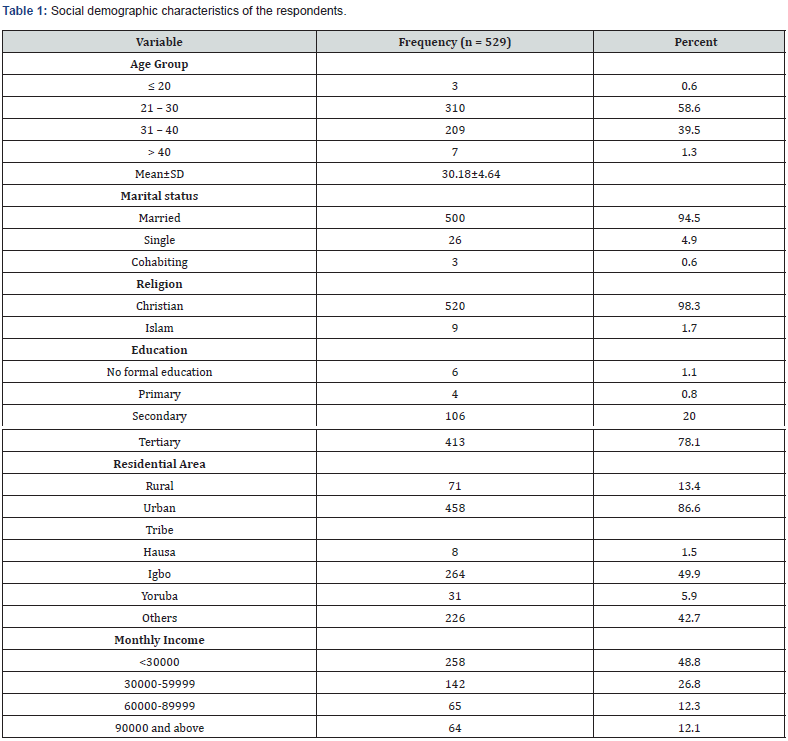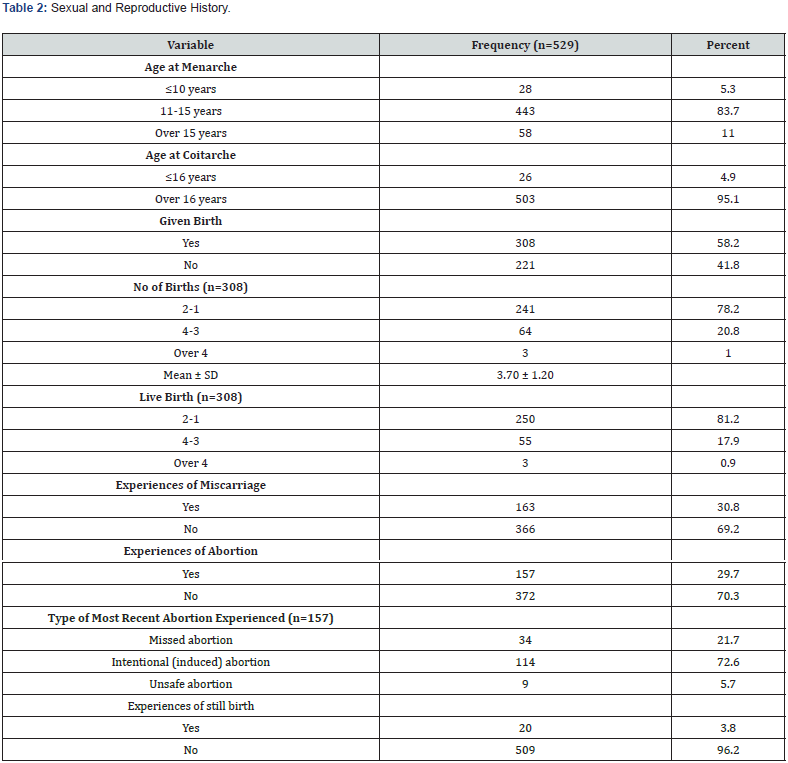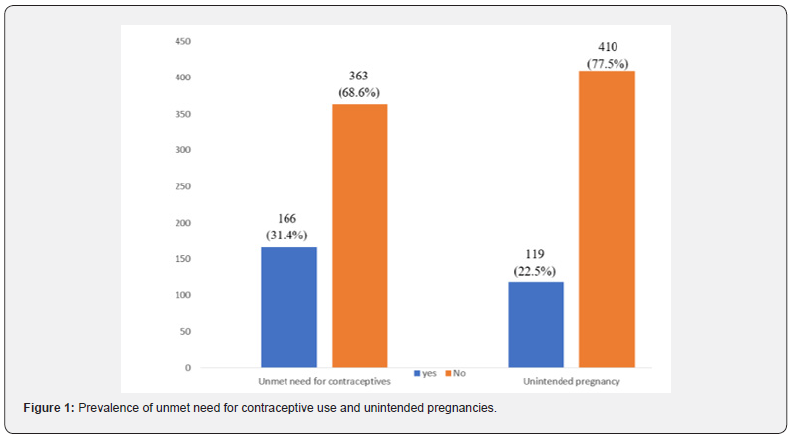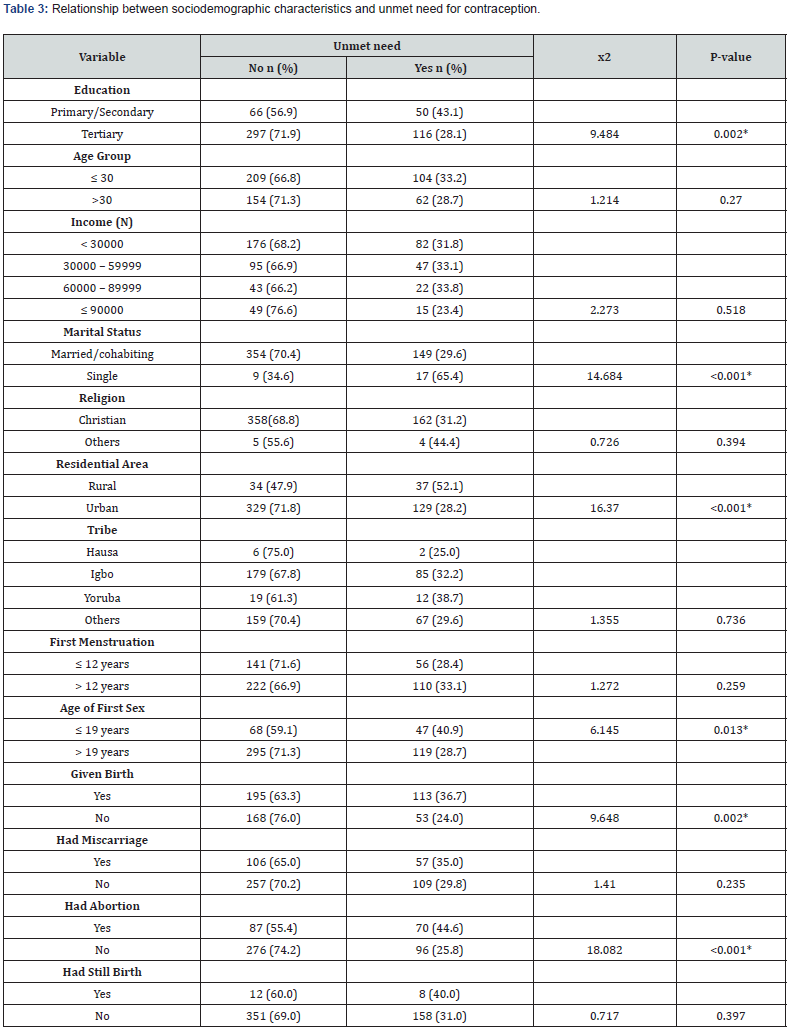Unmet Need for Contraception and Unintended Pregnancies Among Pregnant Women Attending Antenatal Clinic at A Tertiary Healthcare Facility in Port Harcourt
Kasso Terhemen1*, Tella Omolara2 and Alegbeleye Justina Omoikhefe1
1Department of Obstetrics and Gynaecology, University of Port Harcourt, Nigeria
2Department of Preventive and Social Medicine, University of Port Harcourt, Nigeria
Submission: June 13, 2023; Published: June 26, 2023
*Corresponding author: Kasso Terhemen, Department of Obstetrics and Gynaecology, University of Port Harcourt, Nigeria
How to cite this article: Kasso T, Tella O, Alegbeleye Justina O. Unmet Need for Contraception and Unintended Pregnancies Among Pregnant Women Attending Antenatal Clinic at A Tertiary Healthcare Facility in Port Harcourt. J Gynecol Women’s Health 2023: 25(2): 556160. DOI: 10.19080/JGWH.2023.25.556160
Abstract
Background: Promoting family planning has long been recognised as a viable technique for minimising the risk of unplanned pregnancies, unsafe abortion, and maternal death. Due to Nigeria’s low contraceptive prevalence of 17%, a wide variety of women are susceptible to unmet need for contraception and an elevated risk of unwanted births.
Aim: To determine the rate of unmet need and unintended pregnancies among women attending antenatal clinic at the University of Port Harcourt Teaching Hospital (UPTH).
Materials and Methods: This was a descriptive cross-sectional study that involved 529 women via a systematic sampling technique. Data was collected with the aid of a semi-structured interviewer-administered questionnaire and analysed using Statistical Product and Service Solutions (SPSS) version 25.
Results: According to the findings, the rates of unintended pregnancies and unmet need for contraception were 22.5% and 31.4% respectively. Education, marital status, residence, early sexual debut, parity and abortion were significantly associated with unmet need.
Conclusion: The study showed high rate of unmet need and unwanted pregnancies. Hence, health workers should intensify efforts in creating awareness and sensitizing the populace in order to address the identified barriers to contraceptive use.
Keywords: Unintended pregnancy; Contraception; Unmet need; Family planning
Introduction
Pregnancy and subsequently birth are considered to be one of the most crucial events in a woman’s reproductive life cycle, but could sometimes be unintended or unwanted [1,2]. This kind of pregnancy results from unmet need for contraception, improper use or failure of a method [3], as reports show that there are around 885 million women of reproductive age (15–49 years) in developing nations who desire to postpone having a child but do not currently use a Modern Contraceptive (MC) technique [4]. Apart from intended pregnancies, mistimed and unintended pregnancies may end up being aborted, usually in an unsafe manner. This is disturbing since 25% of unplanned pregnancies result in abortions, and three out of four abortions in Sub Saharan Africa (SSA) are carried out covertly in unsafe conditions thereby predisposing the women to life-threatening conditions which often lead to maternal death [5-7]. This is because strict abortion regulations exist in several SSA nations, including Nigeria, where abortion is only medically indicated to save a mother’s life [8].
Further report also shows that some women choose abortion over contraception as a method of child spacing [9]. This might be one of the reasons why the country has such a low contraceptive prevalence rate [9]. According to Ajayi, Adeniyi and Akpan [10], though there has been global increase in the usage of contraceptives among women aged 15 to 49 years from 55% in 1990 to 64% in 2015, there are still considerable differences between nations, with poorer countries lagging far behind. This lag is more predominant in SSA where there is the greatest rate of non-use of MCs, contributing for 21% of the global unmet demand for MC [11]. Hence, the need to investigate the unmet contraceptive need, and unwanted pregnancy among women from various socioeconomic backgrounds in Port Harcourt, Rivers State, Nigeria.
Materials and Methods
Study Design and setting
This research was conducted at the Department of Obstetrics and Gynaecology of the University of Port Harcourt Teaching Hospital in Rivers State, Nigeria, from July 1, 2021 to August 31, 2021. It used the descriptive cross-sectional survey method.
Study Population and Sample size determination
The participants in this study were pregnant women who attended the UPTH antenatal clinic (ANC) during the study period as they represent significant target group for postpartum contraceptive counselling and treatment [12]. The study employed the single proportion formula (n = pq*z2/d2) and the systematic sampling method in recruiting a total of 529 consenting respondents for the study, with the confidence interval set as 95%, degree of accuracy/precision set at 0.05, percentage of married women with unmet need for family planning (19%) [13], considering 10% non-response rate and applying the design effect of 2The minimum sample size was 520. However, 529 participants were recruited for the study.
Study Instrument
The study made use of a semi-structured intervieweradministered questionnaire which was adapted from the Nigeria Demographic and Health survey (NDHS) questionnaire [13]. The questionnaire was made to suit the scope of this study and used to collect data on the sociodemographic characteristics and reproductive history of the respondents, as well as their use of modern contraceptives and occurrence of unintended pregnancy.
Statistical Analysis
The data analysis was performed using Microsoft Excel 2019 and IBM Statistical Product and Service Solutions (SPSS) version 25.0 (Chicago, IL, USA). Microsoft Excel was used for data cleaning, editing, sorting, and coding the data before importing it into SPSS software for onward analysis. Data on sociodemographic characteristics, reproductive health history and practice of contraception by the participants were summarized as frequency counts and percentages. The association between unmet need for contraception and unwanted pregnancies was investigated using Chi-square and regression analysis. All tests were regarded statistically significant at p<0.05.
The socio-demographic detail of the respondents is presented in Table 1. The result showed that majority of the respondents, 310 (58.6%), were aged between 21 to 30 years while their mean age was 30.18 ± 4.64. Majority of them also reported that they were married (94.5%), Christians (98.3%), completed tertiary education (78.1%), resided in an urban area (86.6%), were of the Igbo tribe (49.9%) and earned less than N30,000 a month (48.8%).

The study also investigated the sexual and reproductive history of the women and presented the result in table 2. According to the finding, age at menarche for majority of the respondents was 11 to 15 years (83.7%), while majority had their first sexual intercourse when they were over 16 years (95.1%). Over half of the respondents reported that they had given birth (58.2%), while 78.2% of them had 1 to 2 births of which 81.2% had 1 to 2 live births. Also, 30.8% reported that they have had a miscarriage, while 29.7% have had an abortion, of which 72.6% reported that the type of most recent abortion they had was an intentional (induced) abortion. Only 20 (3.8%) reported that they have had a still birth.

The prevalence of unintended pregnancies and unmet need for contraception (UNC) among the respondents is seen in figure 1. The prevalence of unwanted pregnancy was 22.5% according to the desire for number of children, child spacing, and current pregnancy, as indicated in the chart. On the other hand, 31.4% of the women in this research had unmet need for contraception.

The study also looked into the variables that contributed to unmet need for contraception (UNC). The result as presented in table 3 shows that the respondents’ educational status (completed primary or secondary education), marital status (single), and area of residence (rural) all had a negative statistically significant (p<0.05) relationship with unmet need for contraception. Also, age of sexual debut (≤ 19 years), parity and ever had an abortion were seen to have a negative statistically significant (p<0.05) relationship with unmet need for contraception.
Table 4 shows the multivariate logistic regression analysis for predictors of unmet need for contraception. Single women, rural residence, knowledge of contraception and those that had given birth were all significantly associated with unmet need for contraception. According to the result, single women were 4.79 times at odds of having unmet contraceptive needs compared with women that were either married or cohabiting (aOR = 4.79; 95% CI: 1.95-11.77; p = 0.001). Respondents in rural settlements were 2 times more likely to have unmet need for contraception compared to those residing in urban areas (aOR = 2.00, 95% CI: 1.21 – 3.04; p = 0.001). Similarly, Respondents who had given birth were 2.46 times more likely to have unmet contraceptive needs compared to respondents who had not given birth (aOR = 2.46; 95% CI: 1.59 – 3.81; p < 0.001). However, there was no statistically significant relationship between education and age at sexual debut with unmet need for contraception after adjusting for confounders.

*Statistically significant (p<0.05)

*Statistically significant (p<0.05); R = reference
Discussion
Unmet Need for Contraception
The use of contraception, unmet need, and unwanted pregnancies among women have been considered as a global problem with major consequences for maternal health. Due to a lack of usage or high unmet need for contraception, there have been incidents of unexpected and undesired pregnancies, which are usually terminated without the women being aware of the health concerns. Addressing the causes of unwanted pregnancies and the barriers to contraceptive usage is a sure way of enhancing the health of mothers and their newborns. The prevalence of unmet need for contraceptives among the respondents in this study was 31.4%. The unmet need in this study was higher than that of the NDHS report of 2018 which puts it at 19% among married women [13], while Wang and Cao [11] did report lower prevalence rate of 13.5% among Nigerian women. Woldemicael [14] in Eritrea, Lata et al in India, Ajong et al in Cameroon, Bishwajit et al in Bangladesh and Habib et al in Pakistan [15-18] reported lower prevalence of unmet need for contraception (27%, 23.9%, 20.4%, 21.4% and 20.1% respectively), while Mekonnen and Worku in Ethiopia, Kande in Nepal, Ali and Okud in eastern Sudan, and Yaya and Ghose in Angola [2,19-21], reported higher rates (52.4%, 48%, 44.8% and 51.7% respectively). These differences in the rates of unmet need for contraception as seen in the various studies might be due to the socio-cultural differences, difference in health service provision and study population. Also, this high rate of unmet need for contraception can be implicated in increased rate of unwanted pregnancy as well as patronage of unsafe abortion and increased population growth in the state where the study was conducted.
Unintended pregnancy
Unintended pregnancy according to Nyarko [22], is seen as a key concept for a better understanding of fertility and the unmet need for contraception of populations. The prevalence of unintended pregnancy was also probed in this study and the result showed that it was 22.5%. Previously, Lamina [23] and Grindlay et al. [24]. reported a higher prevalence of unintended pregnancy (31.1% and 45% respectively) among women in South West, Nigeria and Ghana respectively. Again, Nyarko [22] reported a higher rate of unintended pregnancy in Ghana (40%), while Bishwajit et al in Bangladesh, Habib et al in Pakistan and Yaya and Ghose in Angola [2,17,18] also reported higher rates of unintended pregnancy (30%, 38.2% and 38.3 % respectively) in their studies. This discrepancy in rates of unintended pregnancy might be as a result of behavioural and socio-cultural differences, the difference in health service provision, study population, and level of government and non-governmental investments focus on maternal health, as well as advanced women empowerment on decision-making towards fertility goals and preferences. This depicts a poor outcome that contributes effectively toward the continuous increase in population growth.
Factors affecting the use of contraceptives
The factors significantly associated with the prevalence of unmet need for contraception in this study were identified to include; low educational status, being single, residing in rural area, early sexual debut, parity, and abortion. This is similar with the report of Olugbenga-Bello et al. [25] which showed that level of education, marital status, parity, and region of residence were the significant predictors of unmet need for contraception.
Campbell et al. [26] and Bishwajit et al. [17] also reported that poverty was significantly associated with unmet need as women from rich household were less likely to report unmet need for contraception. In another study, Alenoghena et al. [27] also discovered that marital status (single) and occupation of the respondents (unemployed) were significantly associated with unmet need.
Furthermore, Acharya [28] and Chanda et al. [29] stated that literate women had a better understanding of their rights and responsibilities and have more freedom, control and participation in decisions around contraceptive use and family planning, hence, the increased prevalence of contraceptive use among the educated. In addition, Habib et al. [18] found a link between living in a rural region and a higher risk of unmet need, owing to higher rates of poverty, illiteracy, low contraceptive knowledge, and limited access to modern contraceptive techniques and services. According to Ajayi et al [10], the high unmet need for contraception among rural respondents could be due to a high allocation of family planning resources favouring urban areas, while Alenoghena et al. [27] added that the influence of occupation on contraception uptake could be related to affordability and the resultant effect of occupation on individuals’ socio-economic status.
Conclusion and Recommendation
According to the findings of this study, there was a significant unmet need for modern contraception among the respondents (31.4%) and high rate of unintended pregnancy (22.5%). The study also identified the factors associated with contraceptive use to include; level of education, marital status, area or residence, early sexual debut, parity and abortion. Hence, since unmet need for contraception is one of the most important indicators for tracking the progress of family planning programmes, it should be maintained as low as possible, if not eliminated entirely, to avoid unintended pregnancies. Health workers should therefore intensify efforts in awareness creation and sensitization activities in order to address the identified factors.
References
- Van Otterloo L, Connelly C, Gould J, Abreo A, Main E, et al. (2018) Mothers at risk. Journal of Perinatal and Neonatal Nursing 32(4): 303-314.
- Yaya S, Ghose B (2018) Prevalence of unmet need for contraception and its association with unwanted pregnancy among married women in Angola. PLoS ONE 13(12): e0209801.
- Kessler K, Goldenberg SM, Quezada L (2010) Contraceptive Use, Unmet Need for Contraception, and Unintended Pregnancy in a Context of Mexico-U.S. Migration. Field Actions Science Report 2: 1-6.
- Darroch JE, Sully E (2017) Adding It Up: Investing in Contraception and Maternal and Newborn Health. Guttmacher Institute, New York, USA.
- Abiodun OM, Balogun OR (2019) Sexual activity and contraceptive use among young female students of Tertiary Educational Institutions in Ilorin, Nigeria. Contraception 79(2): 146-149.
- Oriji VK, Jeremiah I, Kasso T (2009) Induced abortion amongst undergraduate students of University of Port Harcourt. Niger J Med 18(2): 199-202.
- Bankole A, Adewole IF, Hussain R, Awolude O, Singh S, et al. (2015) The incidence of abortion in Nigeria Int Perspect Sex Reprod Health 41(4): 170-181.
- Onoh R, Egede J, Umeora O, Dimejesi I, Lawani L, et al. (2015) Contraceptive prevalence and preference in a cohort of south-east Nigerian women. Patient Prefer Adherence 9: 707-714.
- Monjok E, Smesny A, Essien EJ (2010) Contraceptive Practices in Nigeria: Literature review and recommendation for future policy decisions. Open Access Journal of Contraception 9(1): 9-22.
- Ajayi AI, Adeniyi OV, Akpan W (2018) Maternal health care visits as predictors of contraceptive use among childbearing women in a medically underserved state in Nigeria. J Health Popul Nutr 37(1): 19.
- Wang C, Cao H (2019) Persisting regional disparities in modern contraceptive use and unmet need for contraception among Nigerian women. Biomed Res Int 2019: 1-9.
- Olamijulo JA, Olorunfemi G (2012) Knowledge and practice of contraception among pregnant women attending the antenatal clinic in Lagos University Teaching Hospital. Niger J Med 21(4): 387-393.
- National Population Commission (NPC) [Nigeria] and ICF International (2019) Nigeria Demographic and Health Survey 2018. Key Indicators Report Abuja, Nigeria and Rockville, NPC and ICF, Maryland, USA.
- Woldemicael G (2011) Currently married women with an unmet need for contraception in Eritrea: profile and determinants. Canadian studies in population 38(1-2): 61-81.
- Lata K, Barman SK, Ram R, Mukherjee S, Ram AK, et al. (2012) Prevalence and determinants of unmet need for family planning in Kishanganj district, Bihar, India. Global Journal of Medicine & Public Health 1(4): 29-33.
- Ajong AB, Njotang PN, Yakum MN, Essi MJ, Essiben F, et al. (2016) Determinants of unmet need for family planning among women in urban cameroon: A Cross Sectional Survey in the Biyem-assi health district, Yaoundé. BMC Women's Health 16: 4.
- Bishwajit G, Tang S, Yaya S, Feng Z (2017) Unmet need for contraception and its association with unintended pregnancy in Bangladesh. BMC Pregnancy and Childbirth 17: 186.
- Habib MA, Raynes-Greenow C, Nausheen S, Soofi SB, Sajid M, et al. (2017) Prevalence and determinants of unintended pregnancies amongst women attending antenatal clinics in Pakistan. BMC Pregnancy and Childbirth 17(1): 156.
- Mekonnen W, Worku A (2011) Determinants of low family planning use and high unmet need in Butajira District, South Central ethiopia. Reprod Health 8(1): 37.
- Kande NR (2012) Unmet need for contraception and its associated factors among married women of reproductive age in Simichaur VDC of Gulmi District. Health Prospective 11: 11-14.
- Ali AA, Okud A (2013) Factors affecting unmet need for family planning in eastern Sudan. BMC Public Health 13(1): 102.
- Nyarko SH (2019) Unintended Pregnancy among Pregnant Women in Ghana: Prevalence and Predictors. J Pregnancy 2019: 2920491.
- Lamina MA (2015) Prevalence and determinants of unintended pregnancy among women in south-western Nigeria. Ghana Med J 49(3): 187-194.
- Grindlay K, Dako-Gyeke P, Ngo TD, Eva G, Gobah L, et al. (2018) Contraceptive use and unintended pregnancy among young women and men in Accra, Ghana. PLOS ONE 13(8): e0201663.
- Olugbenga-Bello AI, Adeyemi AS, Adeoye OA, Salawu MO, Aderinoye AA et al. (2016) Contraceptive prevalence and determinants among women of reproductive age group in Ogbomoso, Oyo State, Nigeria. Open Access J Contracept 7: 33-41.
- Campbell MM, Prata N, Potts M (2013) The impact of freedom on fertility decline. J Fam Plann Reprod Health Care 39(1): 44-50.
- Alenoghena I, Yerumoh S, Momoh MA (2019) Knowledge, attitude and uptake of family planning services among women of reproductive age group attending outpatient clinic at a tertiary health institution in Edo State, Nigeria. Journal of Public Health and Epidemiology 11(3): 63-70.
- Acharya Y (2012) Women’s education and intra-household autonomy: evidence from Nepal. Journal of Development and Social Transformation 5(1): 15-20.
- Chanda SK, Howlader MH, Nahar N (2012) Educational status of the married women and their participation at household decision making in rural Bangladesh. International Journal of Advancement in Research and Technology 1(6): 137-146.






























